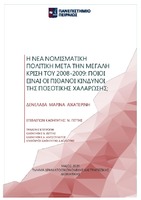Η νέα νομισματική πολιτική μετά την μεγάλη κρίση του 2008-2009: ποιοι είναι οι πιθανοί κίνδυνοι της ποσοτικής χαλάρωσης;

Προβολή/
Λέξεις κλειδιά
Νομισματική πολιτική ; Κεντρικές τράπεζες ; Ποσοτική χαλάρωση ; Επιτόκια ; Πληθωρισμός ; Ομόλογα ; Πρόγραμμα αγοράς περιουσιακών στοιχείων ; Λαϊκό QE ; Ευρωoμόλογο ; Monetary policy ; Central banks ; Quantitative easing ; Interest rates ; Inflation ; Bonds ; Asset purchase program ; Modern monetary theory ; EurobondΠερίληψη
Στην προκείμενη διπλωματική διατριβή, θα διενεργηθεί έρευνα που θέτει ως θεματική τη νομισματική πολιτική που μεταδόθηκε μετά την εκδήλωση της κρίσης του 2008-2009. Αναλυτικότερα, θα επικεντρωθεί στην εφαρμογή του προγράμματος ποσοτικής χαλάρωσης, το οποίο έδρασε ως ένα επιπρόσθετο και αντισυμβατικό – έως πρότινος – μέτρο για το Ευρωσύστημα και τις Ηνωμένες Πολιτείες.
Στα ακόλουθα χωρία θα αποτυπωθεί η δομή των προγραμμάτων που θεσπίστηκαν από τις κεντρικές τράπεζες στην Ευρώπη, τις Η.Π.Α. και την Ιαπωνία, το περιεχόμενο τους και θα εξετασθούν ενδελεχώς οι επιδράσεις τους σε όλο το φάσμα της οικονομίας, όπως στοιχειοθετούνται κι ερμηνεύονται αυτές. Ιδιαίτερη μνεία θα γίνει στο πρόγραμμα ποσοτικής χαλάρωσης που ακολουθήθηκε από την Ομοσπονδιακή Τράπεζα των Η.Π.Α. και πώς αυτό αποτιμάται.
Επιπροσθέτως, θα αναφερθεί κι η εναλλακτική και πιο ανθρωποκεντρική «εκδοχή» της ποσοτικής χαλάρωσης όπως προτάθηκε, θέτοντας στο επίκεντρο την κοινωνική ευημερία, πέρα από το αποτύπωμα στις χρηματαγορές αλλά και υποδεικνύοντας το ρόλο που θα πρέπει λάβουν οι κεντρικές τράπεζες στη δημιουργία χρήματος ώστε να επιτευχθεί ένας ενάρετος οικονομικός κύκλος.

